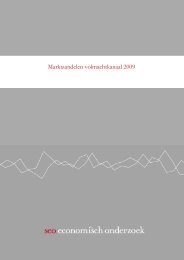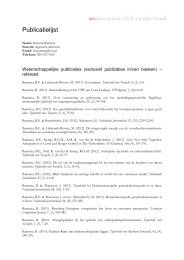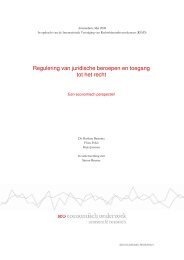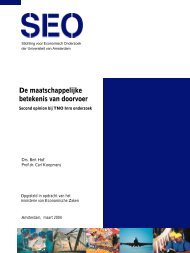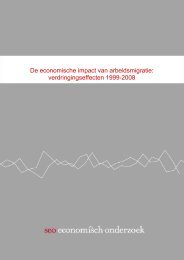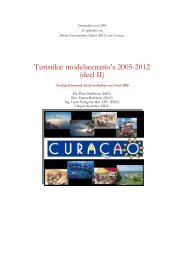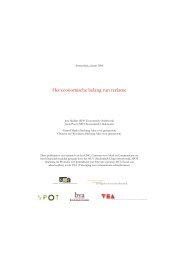Amsterdam, Netherlands - SEO Economisch Onderzoek
Amsterdam, Netherlands - SEO Economisch Onderzoek
Amsterdam, Netherlands - SEO Economisch Onderzoek
Create successful ePaper yourself
Turn your PDF publications into a flip-book with our unique Google optimized e-Paper software.
community and the regional public authorities likewise recognize that the economic future of theregion crucially depends on the region’s ability to step up investment in innovation and R&D.The second critical success factor is the match between such innovation coalitions and thecompetitive strengths of the region. The extensive health care sector with two university hospitalsprovide a fertile soil for the Life Sciences cluster. Likewise the logistics sector plays uponcomparative regional advantages, such as the presence of the <strong>Amsterdam</strong> harbor and Schiphol, amajor international air hub. The same applies to the creative industry, which can only thrivebecause of the extensive offer of cultural facilities and education in the region. In the <strong>Amsterdam</strong>metropolitan area the interaction of productive and creative capital is a major driver for social andeconomic development. A further example concern leisure and tourism, an import economicsector in <strong>Amsterdam</strong> and one of the focal points in the educational program of HogeschoolINHolland, which so contributes to better knowledge, skills and innovation in this sector.Finally, the lack of a central governing force can be mentioned which has resulted in multipleinnovative initiatives in many different directions. This has allowed the region to swiftly react tonew opportunities when they arise.Coalition building for innovation…The regional innovation system described in this report hosts different forms of collaboration.First, the HEIs determine their own research agenda and educational program. The specificpriorities of these agenda’s are the province of the individual institutions and are connected totheir mission. HvA and UvA are examples of this approach. They explicitly include contributionto regional development among their strategic goals and their research and educational prioritiesreflect this objective. However, the execution of these research agenda’s is increasingly done incooperation with regional partners. The development of joint research schools like the TinbergenInstitute is on the agenda for at least the past 20 years. Of more recent date is the effort to broadenthe coalition supporting such initiatives as a means to increase its social and economic impact.The Duisenberg School of Finance is an example of this, hosted by both universities with supportby the Dutch central bank, commercial banks and the city community. The <strong>Amsterdam</strong>University College, which opens its doors this fall, is likewise supported by both universities, thecity and the national government. The <strong>Amsterdam</strong> BioMed cluster is an example of a successfuljoining of forces in the medical sector with the Life Science Center <strong>Amsterdam</strong> and the LifeScience Fonds <strong>Amsterdam</strong> as two of its major products.The second level where coalition formation is on the rise concerns the regional government. Theconception of the <strong>Amsterdam</strong> metropolitan area is testimony of this development as a governingboard of almost 40 different regional governments. PRES (2009) demonstrates that these regionalgovernments recognize that their economic development is strongly intertwined and thatcooperation is needed to strengthen their mutual positions. The result is an economic agenda withspecific targets for action, like the selection of key economic sectors.We have seen that, thirdly, the business community is likewise assessing its comparativeadvantage which resulted in a regional innovation strategy from the Chamber of Commerce(KVK, 2008). Further corporations from the region partake in several of the bodies for regionaldialogue such as the Kenniskring and financially initiatives which aim to strengthen theknowledge base in the region and its competitive position such as the Duisenberg School ofFinance.These different coalitions indicate that all regional stakeholders recognize the importance of theknowledge sector and hence the HEIs as a key economic variable for future economicdevelopment. The next step in this process is improved coordination of these different agenda’sas a means to ensure their effectiveness.128



